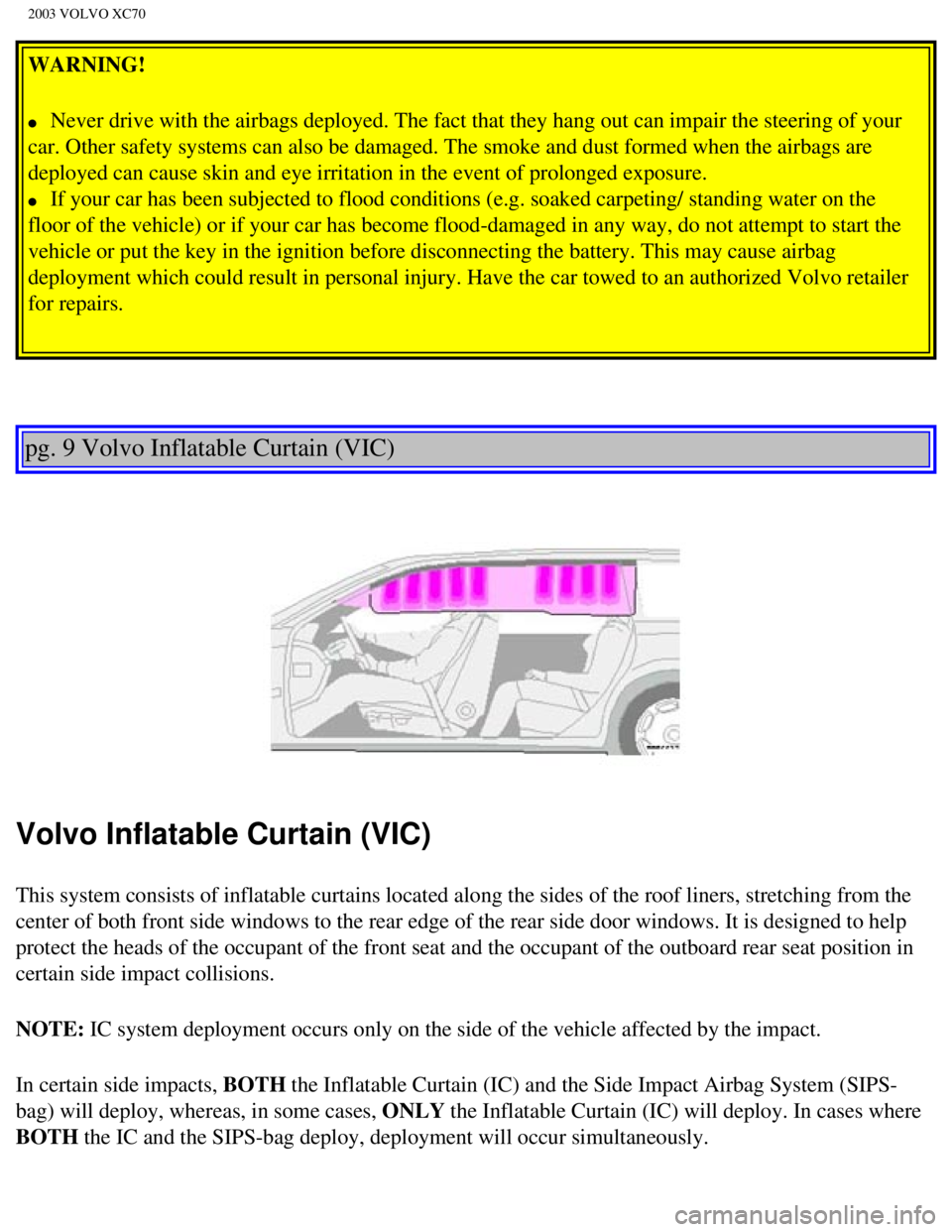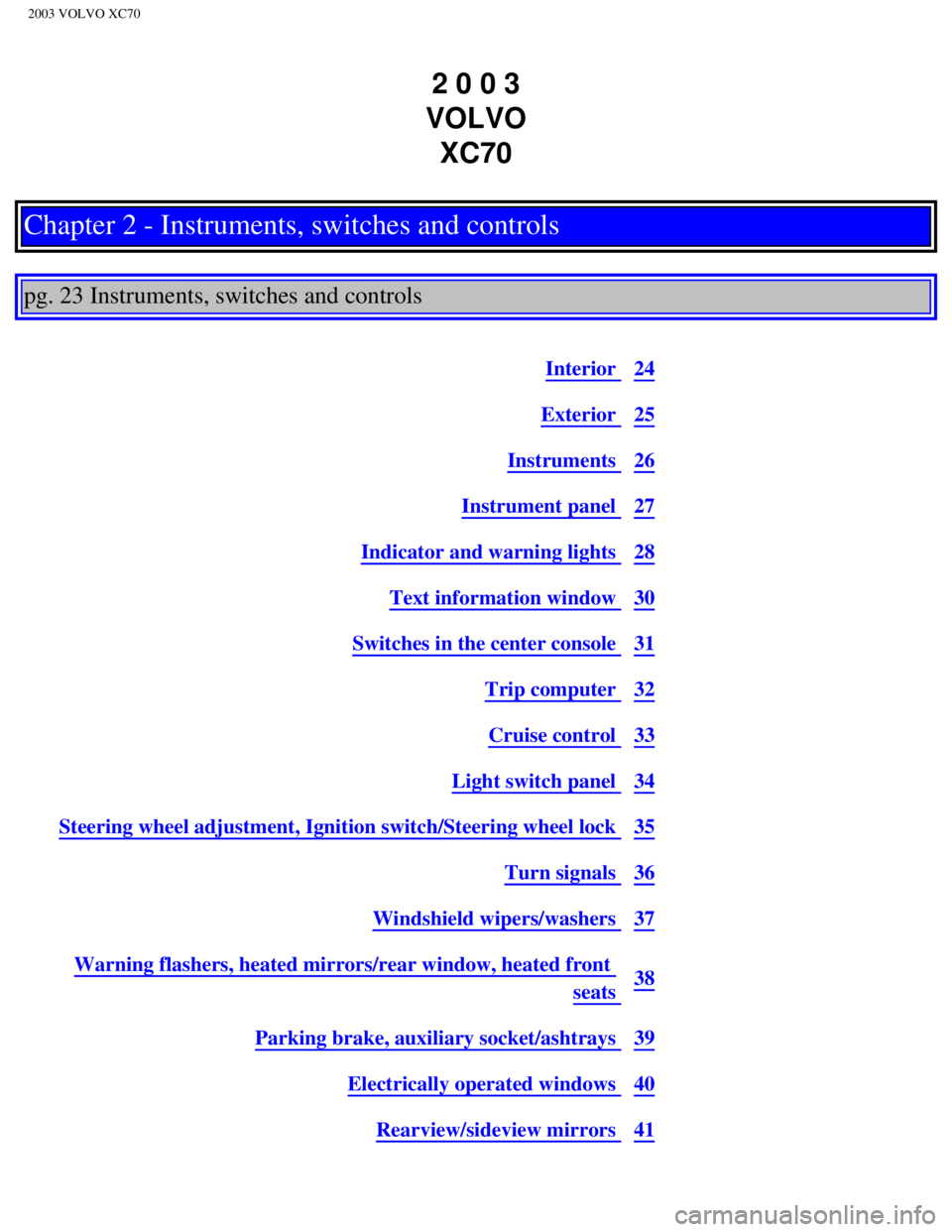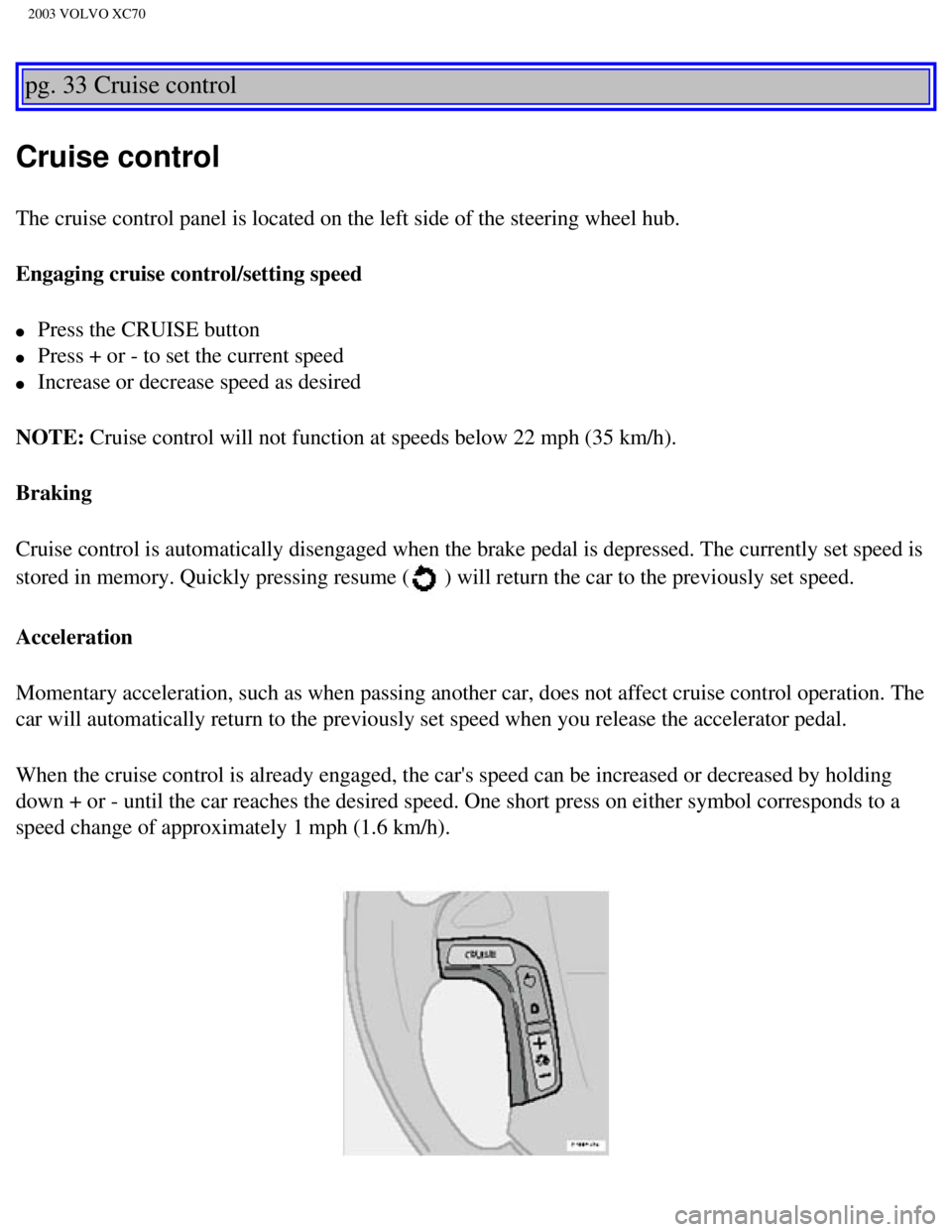2003 VOLVO XC70 steering
[x] Cancel search: steeringPage 11 of 257

2003 VOLVO XC70
WARNING!
l As its name implies, SRS is designed to be a SUPPLEMENT to - not a repla\
cement for - the three-
point belt system. For maximum protection, wear seat belts at all times.\
Be aware that no system can
prevent all possible injuries that may occur in an accident.
l When installing any accessory equipment, make sure that the SRS system i\
s not damaged. Do not
attempt to service any component of the SRS yourself. Attempting to do s\
o may result in serious
personal injury. If a problem arises, take your car to the nearest autho\
rized Volvo retailer for
inspection as soon as possible.
pg. 4 Front airbags - SRS
Driver's side airbag - in
steering wheel hub
Passenger's side airbag - above
glove compartment
As an enhancement to the three-point seat belt system, your Volvo is equ\
ipped with a Supplemental
Restraint System (SRS). The Volvo SRS consists of an airbag (2) on b\
oth the driver's and passenger's
sides and seat belt tensioners in both front door pillars (4). The sys\
tem is designed to supplement the
protection provided by the three-point seat belt system. All three rear \
seat belts are also equipped with
tensioners.
The SRS system is indicated by the "SRS" embossed on the steering wheel \
pad and above the glove
compartment, and by decals on both sun visors and on the front and far r\
ight side of the dash.
The airbags are folded and located in the steering wheel hub and above t\
he glove compartment. They are
designed to deploy during certain frontal or front-angular collisions, i\
mpacts, or decelerations,
depending on the crash severity, angle, speed and object impacted. The a\
irbags may also deploy in
certain non-frontal collisions where rapid deceleration occurs.
The airbag system includes gas generators (1) surrounded by the airbag\
s (2) and front seat belt
tensioners for both of the front seats (4). To deploy the system, the \
sensor (3) activates the gas
generators causing the airbags to be inflated with nitrogen gas. As the \
movement of the seats' occupants
compresses the airbags, some of the gas is expelled at a controlled rate\
to provide better cushioning.
file:///K|/ownersdocs/2003/2003_XC70/03xc70_01a.htm (5 of 17)12/30/200\
6 4:17:51 PM
Page 13 of 257

2003 VOLVO XC70
monitor the Side Impact Protection System (SIPS) airbags. If a fault i\
s detected, the warning light will
illuminate. The light is included in the warning/indicator light cluster\
in the instrument panel. Normally,
the SRS warning lamp should light up when the ignition key is turned to \
positions I, II or III and should
go out after 7 seconds or when the engine is started. Check that this li\
ght is functioning properly every
time the car is started.
The following items are monitored by the self-diagnostic system:
l Sensor unit
l Cable harness
l Gas generator igniters
WARNING!
l Never drive an SRS equipped car with your hands on the steering wheel pa\
d / airbag housing.
l No objects, accessory equipment or stickers may be placed on, attached t\
o or installed near the
SRS cover in the center of the steering wheel, the SRS cover above the g\
love compartment or the area
affected by airbag deployment.
l If the SRS warning light stays on after the engine has started or if it \
comes on while you are
driving, drive the car to the nearest authorized Volvo retailer for insp\
ection as soon as possible.
There is no maintenance to perform on the SRS yourself. The month and ye\
ar shown on the decal on the
door pillar indicate when you should contact your Volvo retailer for spe\
cific servicing or replacement of
airbags and seat belt tensioners. This service must be performed by an a\
uthorized Volvo retailer.
Should you have any questions about the SRS system, please contact your \
authorized Volvo retailer or
Volvo Customer Support:
file:///K|/ownersdocs/2003/2003_XC70/03xc70_01a.htm (7 of 17)12/30/200\
6 4:17:51 PM
Page 16 of 257

2003 VOLVO XC70
WARNING!
l Children must never be allowed in the front passenger seat. Volvo recomm\
ends that ALL
occupants (adults and children) shorter than 4 feet 7 inches (140 cm)\
be seated in the back seat of any
vehicle with a passenger-side front airbag. See
page 14 for guidelines.
l Occupants in the front passenger's seat must never sit on the edge of th\
e seat, sit leaning toward the
instrument panel or otherwise sit out of position. The occupant's back m\
ust be as upright as comfort
allows and be against the seat back with the seat belt properly fastened\
.
l Feet must be on the floor, e.g. not on the dash, seat or out of the wind\
ow.
l No objects or accessory equipment, e.g. dash covers, may be placed on, a\
ttached to or installed
near the SRS hatch (the area above the glove compartment) or the area \
affected by airbag deployment
(see illustration on
page 4 ).
l There should be no loose articles, e.g. coffee cups, on the floor, seat \
or dash area.
l Never try to open the SRS cover on the steering wheel or the passenger s\
ide dash. This should only
be done by an authorized Volvo service technician.
l Failure to follow these instructions can result in injury to the vehicle\
occupants.
pg. 7 Front airbags - SRS
NOTE: The information on this page does not pertain to the Side Impact Protect\
ion System airbags.
When are the airbags deployed?
The SRS system is designed to deploy during certain frontal or front-ang\
ular collisions, impacts, or
decelerations, depending on the crash severity, angle, speed and object \
impacted. The SRS sensor is
designed to react to both the impact of the collision and the inertial f\
orces generated by it and to
determine if the intensity of the collision is sufficient for the airbag\
s to be deployed.
WARNING!
The SRS is designed to help prevent serious injury. Deployment occurs ve\
ry quickly and with
considerable force. During normal deployment and depending on variables \
such as seating position,
one may experience abrasions, bruises, swellings, or other injuries as a\
result of airbag(s) deployment.
If the airbags have been deployed, we recommend the following:
file:///K|/ownersdocs/2003/2003_XC70/03xc70_01a.htm (10 of 17)12/30/20\
06 4:17:51 PM
Page 18 of 257

2003 VOLVO XC70
WARNING!
Never drive with the airbags deployed. The fact that they hang out can i\
mpair the steering of your car.
Other safety systems can also be damaged. The smoke and dust formed when\
the airbags are
deployed can cause skin and eye irritation in the event of prolonged exp\
osure.
pg. 8 Side impact airbags (SIPS)
SIPS airbag *
SIPS airbag (front seats only)
As an enhancement to the structural Side Impact Protection System built \
into your car, the car is also
equipped with Side Impact Protection System (SIPS) airbags. The SIPS a\
irbag system consists of airbag
modules built into the sides of both front seat backrests (1), wires (\
2) and gas generators/sensor units (3).
The SIPS airbag system is designed to help increase occupant protection \
in the event of certain side
impact collisions. The SIPS airbags are designed to deploy only during c\
ertain side-impact collisions,
depending on the crash severity, angle, speed and point of impact. The a\
irbags are not designed to
deploy in all side impact situations.
file:///K|/ownersdocs/2003/2003_XC70/03xc70_01a.htm (12 of 17)12/30/20\
06 4:17:51 PM
Page 20 of 257

2003 VOLVO XC70
WARNING!
l Never drive with the airbags deployed. The fact that they hang out can i\
mpair the steering of your
car. Other safety systems can also be damaged. The smoke and dust formed\
when the airbags are
deployed can cause skin and eye irritation in the event of prolonged exp\
osure.
l If your car has been subjected to flood conditions (e.g. soaked carpeti\
ng/ standing water on the
floor of the vehicle) or if your car has become flood-damaged in any wa\
y, do not attempt to start the
vehicle or put the key in the ignition before disconnecting the battery.\
This may cause airbag
deployment which could result in personal injury. Have the car towed to \
an authorized Volvo retailer
for repairs.
pg. 9 Volvo Inflatable Curtain (VIC)
Volvo Inflatable Curtain (VIC)
This system consists of inflatable curtains located along the sides of t\
he roof liners, stretching from the
center of both front side windows to the rear edge of the rear side door\
windows. It is designed to help
protect the heads of the occupant of the front seat and the occupant of \
the outboard rear seat position in
certain side impact collisions.
NOTE: IC system deployment occurs only on the side of the vehicle affected by \
the impact.
In certain side impacts, BOTH the Inflatable Curtain (IC) and the Side Impact Airbag System (SIPS-\
bag) will deploy, whereas, in some cases, ONLY the Inflatable Curtain (IC) will deploy. In cases where
BOTH the IC and the SIPS-bag deploy, deployment will occur simultaneously.
file:///K|/ownersdocs/2003/2003_XC70/03xc70_01a.htm (14 of 17)12/30/20\
06 4:17:51 PM
Page 34 of 257

2003 VOLVO XC70
Driving in rain and slush or passing through an automatic car wash can c\
ause water to collect on the
brake discs and pads. This will cause a delay in braking effect when the\
pedal is depressed. To avoid
such a delay when the brakes are needed, depress the pedal occasionally \
when driving through rain,
slush etc. This will remove the water from the brakes. Check that brake \
application feels normal. This
should also be done after washing or starting in very damp or cold weath\
er.
Severe strain on the brake system
The brakes will be subject to severe strain when driving in mountains or\
hilly areas or towing. Vehicle
speed is usually slower, which means that the cooling of the brakes is l\
ess efficient than when driving on
level roads. To reduce the strain on the brakes, shift into a lower gear\
and let the engine help with the
braking. Do not forget that, if you are towing a trailer, the brakes wil\
l be subjected to a greater than
normal load.
pg. 19 Anti-lock Brake System (ABS)
Anti-lock Brake System (ABS)
If the warning lamp lights up there is a malfunction of the ABS system (\
the standard braking system will
however function) and the vehicle should be driven cautiously to a Volv\
o retailer for inspection. The
Anti-lock Braking System (ABS) helps to improve vehicle control (stop\
ping and steering) during severe
braking conditions by limiting brake lockup. When the system "senses" im\
pending lockup, braking
pressure is automatically modulated in order to help prevent lockup, whi\
ch could lead to a skid.
The system performs a self-diagnostic test when the engine is started an\
d when the vehicle first
reaches a speed of approximately 12 mph (20 km/h). The brake pedal will pulsate several times and a
sound may be audible from the ABS control module. This is normal.
To obtain optimal effect from the ABS system, constant pressure should b\
e kept on the brake
pedal, keep constant pressure on the brake pedal. Do not pump the brake \
pedal.
The switching of the ABS modulator will be audible and the brake pedal w\
ill pulsate during braking.
Please be aware that ABS does not increase the absolute braking potentia\
l of the vehicle. While control
will be enhanced, ABS will not shorten stopping distances on slippery su\
rfaces.
ABS with EBD (Electronic Brake Force Distribution)
EBD is an integrated part of the ABS system. EBD regulates the hydraulic\
pressure to the rear brakes to
help provide optimal braking capacity. The brake pedal will pulsate duri\
ng braking, which is normal.
file:///K|/ownersdocs/2003/2003_XC70/03xc70_01b.htm (11 of 14)12/30/20\
06 4:17:52 PM
Page 38 of 257

2003 VOLVO XC70
2 0 0 3
VOLVO XC70
Chapter 2 - Instruments, switches and controls
pg. 23 Instruments, switches and controls
Interior 24
Exterior 25
Instruments 26
Instrument panel 27
Indicator and warning lights 28
Text information window 30
Switches in the center console 31
Trip computer 32
Cruise control 33
Light switch panel 34
Steering wheel adjustment, Ignition switch/Steering wheel lock 35
Turn signals 36
Windshield wipers/washers 37
Warning flashers, heated mirrors/rear window, heated front
seats 38
Parking brake, auxiliary socket/ashtrays 39
Electrically operated windows 40
Rearview/sideview mirrors 41
file:///K|/ownersdocs/2003/2003_XC70/03xc70_02a.htm (1 of 13)12/30/200\
6 4:17:53 PM
Page 51 of 257

2003 VOLVO XC70
pg. 33 Cruise control
Cruise control
The cruise control panel is located on the left side of the steering whe\
el hub.
Engaging cruise control/setting speed
l Press the CRUISE button
l Press + or - to set the current speed
l Increase or decrease speed as desired
NOTE: Cruise control will not function at speeds below 22 mph (35 km/h).
Braking
Cruise control is automatically disengaged when the brake pedal is depre\
ssed. The currently set speed is
stored in memory. Quickly pressing resume (
) will return the car to the previously set speed.
Acceleration
Momentary acceleration, such as when passing another car, does not affec\
t cruise control operation. The
car will automatically return to the previously set speed when you relea\
se the accelerator pedal.
When the cruise control is already engaged, the car's speed can be incre\
ased or decreased by holding
down + or - until the car reaches the desired speed. One short press on \
either symbol corresponds to a
speed change of approximately 1 mph (1.6 km/h).
file:///K|/ownersdocs/2003/2003_XC70/03xc70_02b.htm (1 of 18)12/30/200\
6 4:17:54 PM